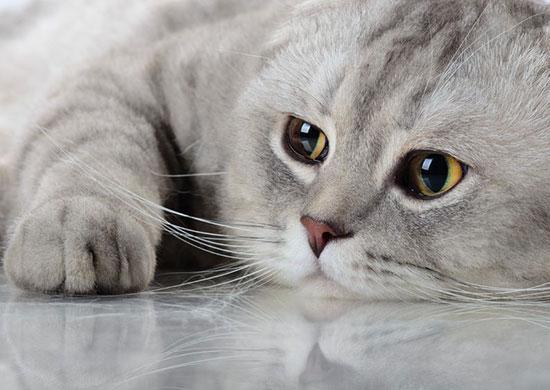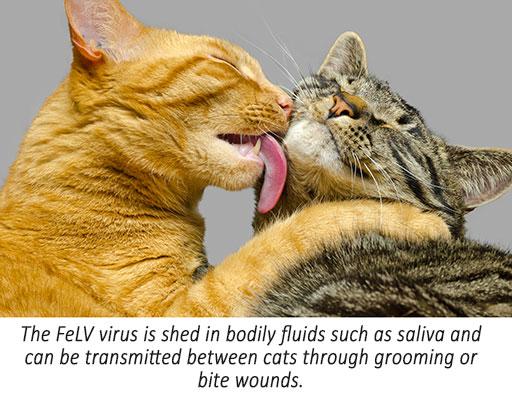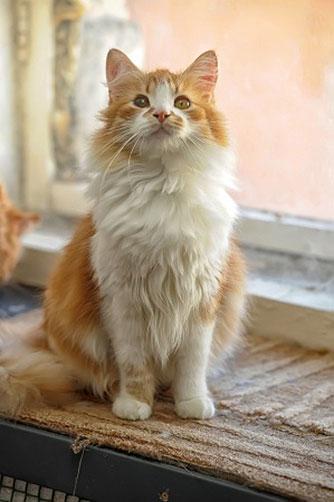This content is archived from the Feline Nutrition Foundation
Nutrition is Vital When Treating Feline Leukemia
- Updated: Saturday, June 01, 2019 02:42 PM
- Published: Saturday, January 31, 2015 06:10 PM
- Written by Guillermo Díaz. MV
 The feline leukemia virus, generally referred to as FeLV, is classified by virologists as a retrovirus. A retrovirus uses an enzyme called reverse transcriptase to insert copies of its own genetic material into the cells it has infected in order to produce a new copy of a whole virus. Infected cats can be found everywhere, but the prevalence varies depending on many factors: age, health, reproductive status, concurrent disease, environment and lifestyle. The worldwide prevalence is about 5% of free-roaming cats. In the United States, approximately 2 to 3% of all cats are infected with FeLV. Rates rise significantly, above 10%, in sick cats, youngsters or cats otherwise at high risk of infection.¹
The feline leukemia virus, generally referred to as FeLV, is classified by virologists as a retrovirus. A retrovirus uses an enzyme called reverse transcriptase to insert copies of its own genetic material into the cells it has infected in order to produce a new copy of a whole virus. Infected cats can be found everywhere, but the prevalence varies depending on many factors: age, health, reproductive status, concurrent disease, environment and lifestyle. The worldwide prevalence is about 5% of free-roaming cats. In the United States, approximately 2 to 3% of all cats are infected with FeLV. Rates rise significantly, above 10%, in sick cats, youngsters or cats otherwise at high risk of infection.¹
Cats with persistent FeLV infection serve as sources for the spread of the disease. Virus is shed in large amounts through bodily fluids: saliva and nasal secretions, urine, feces and milk. Cat-to-cat transfer of the virus may occur from a bite wound, during mutual grooming and less often by sharing litter boxes and feeding dishes. In utero transmission can also take place from infected queens or while they are nursing. FeLV cannot survive long outside a cat's body because the virus needs the living cells to replicate.² Cats most susceptible to infection are the ones in contact with infected cats or with cats of unknown infection status, either via prolonged close contact or through bite wounds. Young kittens, cats less than one year of age and kittens born to a mother who is FeLV positive are most at risk of infection.
Feline leukemia virus causes systemic immunosuppression which hinders the cat's ability to protect itself against other infections. During the early stage of infection, some cats are able to develop an effective immune response.³ Infected cats can be expected to have secondary skin problems, such as recurrent pyoderma. FeLV is the most common cause of cancer in cats and it may cause various blood disorders. The same flora and fauna, such as bacteria, viruses, protozoa and fungi that may be found in the everyday environment – where they usually do not affect healthy animals – can cause fatal disease in those with weakened immune systems. These secondary infections are responsible for many of the diseases associated with FeLV.⁴
If the cat's immune response fails to initially fight the virus, a later stage characterized by persistent infection of the bone marrow and other tissue is developed. If the infection progresses to this stage, it has reached the point of no return. They will remain infected for life. These cats are referred to as having a persistent infection, and actively shed the virus in saliva and other bodily fluids. They are likely to develop FeLV-related diseases.
When cats first become infected with the virus, they generally do not show any signs of disease, but they can transmit the virus to other cats. However, over time – weeks, months, years – the cat's health may progressively deteriorate or be characterized by recurrent illness alternating with periods of relative health. Fortunately, most cats that are exposed to the virus do not become viremic, but recover and develop immunity.⁵ These cats are referred to as having a regressive infection with the virus. They rarely shed the virus and usually do not succumb to FeLV-related illnesses.

- Loss of appetite
- Weight loss
- Enlarged lymph nodes
- Poor coat condition
- Abscesses
- Fever
- Pale mucus membranes
- Gingivitis and stomatitis
- Jaundice
- Infections of the skin, urinary bladder and upper respiratory tract
- Persistent diarrhea
- Behavior changes and other neurological disorders
- Abortion of kittens
The clinical signs listed above are only "signs" or manifestations of a concurrent disease caused by the virus. These diseases can by classified into two categories: malignant and non-malignant. Malignant diseases include lymphoma and leukemia. Non-malignant diseases include anemia, immunodeficiency, enteritis, marrow aplasia and reproductive failure.⁶
There are two types of blood tests available for veterinary use. Both can detect a certain type of protein component of the virus:
- ELISA (enzyme-linked immunosorbent assay) and similar tests can be performed in your veterinarian's office. ELISA-type tests detect both primary and secondary stages of viremia.
- IFA (indirect immunofluorescent antibody assay) tests must be sent out to a diagnostic laboratory. IFA tests detect secondary viremia only, so the majority of positive-testing cats remain infected for life.⁷
Prevention is the best way to protect cats from FeLV exposure. These recommendations can help:
- Keep cats away from potentially infected cats that might fight and bite them. It's safer to keep our cats indoors.
- Consider vaccination of healthy cats if they will be in close contact with an infected cat. Keep in mind that the vaccine is only 70-80% effective. FeLV vaccination of infected cats is not beneficial. Discuss the advantages and disadvantages of vaccination with your veterinarian.
 Having said all of the above I'd like to stress a subject that is not talked about in veterinary medical books or on the internet as to how to improve the quality of life and perhaps accelerate the recovery of sick cats. That topic is nutrition. Medical textbooks are loaded with the names of drugs and different approaches to dealing with infected cats, but nutrition is often dismissed or underestimated.
Having said all of the above I'd like to stress a subject that is not talked about in veterinary medical books or on the internet as to how to improve the quality of life and perhaps accelerate the recovery of sick cats. That topic is nutrition. Medical textbooks are loaded with the names of drugs and different approaches to dealing with infected cats, but nutrition is often dismissed or underestimated.
Sick cats need the best quality of food available because of their catabolic state. Their requirements for protein, fat and energy exceed those of healthy cats, so high-quality nutrition is of the utmost importance. Cats that don't get enough high-quality protein will start to metabolize their own tissues to compensate, leading to wasting and a reduced ability to fight off disease. Balanced raw cat food diets are ideal for superior nutrition. Cats with regressive infection can be fed the usual raw food as their immune systems are not compromised. More care should be taken in cats that have persistent infection with the virus, as the immune system may not be able to handle even normal amounts of pathogens. With these cats, dry food especially should be avoided. Besides the inferior quality of nutrition from kibble-type foods, they are more likely to harbor molds and bacteria than other foods.
You should work with your veterinarian if you are feeding a persistently infected cat a raw meat diet. A few extra steps should be added when making the food. This method can also be used for any cat that may have a compromised immune system, such as a cat that is on steroids. When making the ground raw cat diet, the meat can be baked briefly before grinding to kill surface bacteria. In whole raw meats, pathogens that may have been introduced onto the meat are on the outside only. With "Feline Nutrition's Easy Homemade Cat Food Recipe," place the chicken in a baking dish and bake for about 10 to 15 minutes at 350 degrees Fahrenheit. Then remove the meat from the pan and immediately immerse it in cold water for a minute or two to stop the cooking process. This method will drastically reduce or eliminate any bacteria present. It will cook just the outside of the meat, but that's okay. Do not discard any liquid in the cooking pan; add it into the ground mix. Follow the rest of the recipe as you normally would.
An alternative is to feed a commercially-prepared raw cat food meal that has been HPP, high pressure processing, treated. This method uses pressure to kill bacteria without cooking the food. It is highly effective at eliminating bacteria in foods and is also used for many foods intended for human consumption. In the US, there are a number of national brands that use this method, so they are readily available.
Additional Reading
Care to Compare? Wild vs. Domesticated Prey
High Pressure Processing: The Future of Raw Cat Food?
Feeding your FeLV-infected cat the best possible diet can greatly affect her overall health and ability to fight off the onset of FeLV-associated disease. You don't have to give up feeding raw cat food because of this diagnosis. Fresh raw food contains all of the nutrients, enzymes, vitamins and amino acids your cat needs in an easily digested form. Good food contributes to a fast recovery and will provide a better quality of life for your sick cat.
Dr. Guillermo Díaz and family, including their four dogs (Leroy, Xica, Moza and Pepa) and six cats (Michalina, Tigger, Vladimir, Yellow, Mongo and Chirusa) moved to Buenos Aires, Argentina in July of 2017, where he expects to continue supporting different animal rescue groups, spread the benefits of raw food for cats and dogs and write articles about nutrition.
1. GD Norsworthy, SF Grace, MA Crystal and LP Tilley (editors), The Feline Patient, 4th ed, Wiley-Blackwell, October 2010, 184-186.
2. EA Chandler, RM Gaskell and CJ Gaskell, Feline Medicine and Therapeutics, 3rd ed, Wiley-Blackwell, February 2004, 597-598.
3. MR Lappin, Feline Internal Medicine Secrets, Hanley & Belfus, Inc., March 2001, 327.
4. JR August, Consultas en Medicina Interna Felina, Inter-médica, 1993, 222-224.
5. EA Chandler, RM Gaskell and CJ Gaskell, Feline Medicine and Therapeutics, 3rd ed, Wiley-Blackwell, February 2004, 597-598.
6. GD Norsworthy, SF Grace, MA Crystal and LP Tilley (editors), The Feline Patient, 4th ed, Wiley-Blackwell, October 2010, 184-186.
7. Norsworthy et. al., The Feline Patient.




